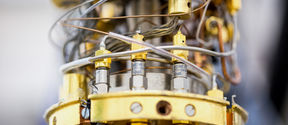OtaNano
OtaNano is Finland's national research infrastructure for micro-, nano-, and quantum technologies
The Nano Steps performance is the brainchild of puppeteer Aati Hanikka, who found the inspiration for the microscopic puppet theatre from an IBM animation called A boy and his atom: The world's smallest movie (Youtube).
'I wanted to find out what the world’s smallest puppet was that could be manipulated in real time. And of course, there had to be movement, which is at the heart of all puppet theatre,' says Hanikka, who is also the director of the performance.
Soon after the idea was born, dramaturg Iiris Syrjä and sound designer Valtteri Alanen joined Hanikka to form the Trial & Theatre group. The trio set out to create Nano Steps, a performance which closely resembles a research process, with the aim of blurring the boundaries between science and puppetry.
‘In art and in science, curiosity about the new is always the driving force,’ Alanen says.
Instead of having a traditional puppet on stage, the performance is based on physics, specifically on the manipulation of microparticles using both sound waves and electricity. From the spotlight of the microscope, the movement is then projected onto a screen onstage.
The trio’s first challenge was to find out whether the project was even possible – could they perform puppet theatre under a microscope? They consulted world-famous scientists at Helsinki University, the Czech Academy of Sciences in Prague and finally Cornell University in New York. At Cornell, they learned how to manipulate microscopic particles.
Once back in Finland, they needed a training lab and access to microparticles. Enter Aalto University and its Department of Applied Physics. Preparing for the performance involved discussions and collaborations with research scientists, including people in Associate Professor Jaakko Timonen’s lab.
The collaboration was facilitated also by the Aalto Networking Platform, which brings experts together inside and outside of Aalto in key research areas. Professor Quan Zhou, who is the leader of the Robotic Instruments Group, helped the group too.
‘I think the key to this collaboration is that we’re not just interpreting or representing physics as puppet theatre, but we’re doing art with real scientific tools and real scientific methods and techniques,’ says Hanikka.
But microparticles don't tend to collaborate, say Nano Steps performer En Ping Yu and light designer Jere Suontausta.
‘In a sense, this is more like research than an art performance, as you never know beforehand what's going to happen. It’s just impossible to control the particles, so instead of trying to control them, we need to have strategies to react to them,’ Suontausta says.
After that, it is up to the viewer to interpret the work, each in their own way. But what’s the underlying message of the show?
'I have often heard Aati say: "Astonishment is the best feeling, and that's what I want to offer to the viewer." It's the kind of worldview that we all have, and our goal is to make the viewer astonished with us,' Syrjä says.
The collaboration was facilitated also by the Aalto Networking Platform, which brings experts together inside and outside of Aalto in key research areas.
The Nano Steps performance was part of Helsinki City Theatre’s pilot project called Stage for Contemporary Performance, which is supported by the Kone Foundation. More information here.
The Nano Steps performance used technology developed using OtaNano, Finland's national research infrastructure for micro-, nano-, and quantum technologies.

OtaNano is Finland's national research infrastructure for micro-, nano-, and quantum technologies



